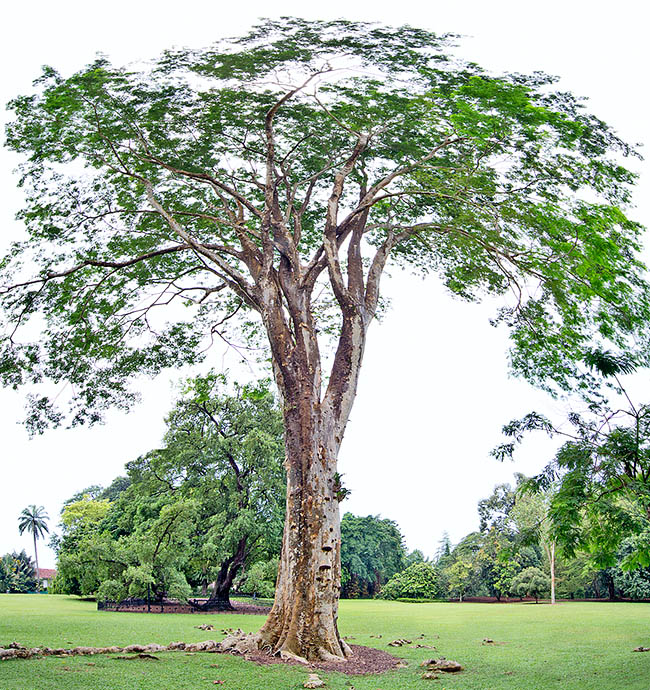Family : Fabaceae

Text © Pietro Puccio

English translation by Mario Beltramini

At home in South-East Asia, Albizia lebbekoides can be 40 m tall. Great landscape value but also shade tree in the tea plantations. From bark they get a dye, a flavouring and a drug for the colics. Rooting apparatus is able to fix the atmospheric nitrogen enriching the soil. The wood, of brown colour, is used to fabricate furniture and fixtures © Giuseppe Mazza
The species is native to Cambodia, East Timor, Indonesia (Java, Lesser Sunda Islands, Sulawesi), Laos, Malaysia, Myanmar, Papua New Guinea, Philippines, Thailand and Vietnam where it mainly lives in the deciduous forests in hilly zones, at the margins of clearings, paths and water streams, in climates characterized by one long dry season.
The genus is honoured to the Italian nobleman Filippo degli Albizzi who, in 1749, introduced in Florence from Con- stantinople the Albizia julibrissin; the specific name is the combination of the name of the species Albizia lebbeck (L.) Benth. (1844) and of the Greek suffix “ -οειδής” (-oeidés), from “εἶδος” (êidos) = shape, look, with reference to the resemblance of the two species.
Common names: châmri:ëk, kântri:ek (Khmer); haluganit, maganhop-sa-bukid (Tagalog); kedinding, tarisi, tekik (Indonesian); h’uung, kh’aang (Laos); koko, siris (Malaysian); anya kokko (Burmese); kungkur (Singaporean); chamari dong, chamari pa, kang (Thai); bản xe trắng, câm-trang, muồng trúc, song râ, xúa (Vietnamese).
The Albizia lebbekoides (DC.) Benth. (1844) is an unarmed deciduous tree up to 40 m tall, but that in cultivation keeps lower, with erect trunk up to 40-60 cm of diameter with wrinkled greyish to reddish brown bark; like other Fabaceae the rooting apparatus is able to fix the atmospheric nitrogen enriching the soil. The leaves, on a 3-6 cm long petiole, are alternate, bipinnate, 5-15 cm long, with 3-8 pairs of paripinnate leaflets, 5-12 cm long, each one composed by 5-30 pairs of opposite sessile leaflets, oblong with asymmetric base, 0,8-2,5 cm long and 0,2-05 cm broad. The terminal or axillar inflorescences are up to 18 cm long panicles, formed by dense capitula of about 1 cm of diameter bearing 10-15 hermaphroditic sessile flowers, 0,8-1 cm long, with greenish penta-parted calyx, about 1,5 mm long, and tubular yellow-greenish penta-parted corolla and several white stamina, 0,6-1 cm long, merged at the base to form a tube. The fruit is an oblong dehiscent legume, flat, 7-15 cm long and 1,5-2,5 cm broad, of yellowish brown colour containing up to 12 almost circular, flat seeds, 0,7 cm long, 0,5 cm broad and 0,1-0,2 cm thick, of brown colour with a thin U-shaped line (pleurogram) on the sides.
It reproduces by seed, previously scarified and kept in lukewarm water for one day, in draining loam maintained humid at the temperature of 23-26 °C, with germination times of 3-5 days.
Cultivable in the tropical and subtropical regions in full sun on even poor soils, is utilized as shade tree in the tea plantations, for the consolidation of the soils, in the reforestation and as ornamental in the road trees. The wood, of brown colour and of good characteristics, is utilized in the constructions and for realizing furniture and fixtures and as fuel; from the bark, rich of tannins, they get a dye and in the Philippines is used for aromatizing a drink obtained from the fermentation of sugar cane. Locally, the bark is utilized in the traditional medicine as a remedy in colics.
Synonyms : Acacia lebbekoides DC. (1825); Albizia julibrissin “sensu auct., non Durazz.”; Albizia julibrissin “sensu Fern.-Vill., non Durazz.”; Albizia lebbekioides (DC.) Benth. (1844); Mimosa carisquis Blanco (1837); Pithecellobium myriophyllum Gagnep. (1911).
→ To appreciate the biodiversity within the family of FABACEAE please click here.
